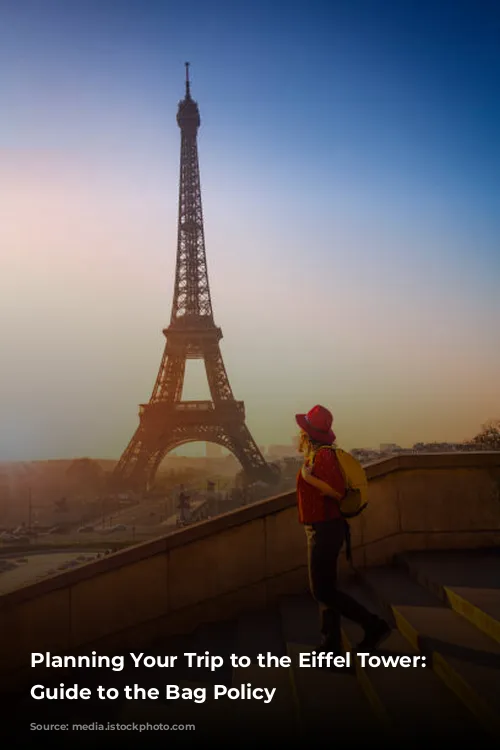Visiting the Eiffel Tower is a dream for many travelers! To make sure your experience is smooth and enjoyable, it’s essential to understand the bag policy. This guide will cover everything you need to know, from size restrictions to prohibited items, ensuring a hassle-free visit.

Bag Policy & Security
Safety is paramount! The Eiffel Tower has a bag policy in place to keep everyone safe. Here’s what you need to know:
- Bag Size: You’re allowed to bring bags, backpacks, and purses, but they can’t exceed 40cm x 20cm x 55cm (15.7″ x 7.9″ x 21.7″).
- Security Checks: All bags will be inspected when you enter. Be prepared to open your bag for security.

Prohibited Items: What You Can’t Bring
To maintain a secure environment, the Eiffel Tower has a list of items that are strictly prohibited. These include:
- Weapons: Firearms, knives, or any other weapons are not allowed.
- Large Items: Suitcases, large bags, and bulky items are forbidden.
- Glass Containers: Glass bottles, containers, and other glass items are prohibited.
- Alcohol: Alcoholic beverages are not permitted inside the Eiffel Tower.
For a comprehensive list of prohibited items, check out the Eiffel Tower Official Website.

Storage Options: Where to Leave Your Luggage
The Eiffel Tower does not offer storage facilities. If you’re carrying bags that exceed the size restrictions, consider using nearby luggage storage services like Stasher.

Essential Tips for a Smooth Visit
Follow these tips for a stress-free Eiffel Tower experience:
- Pack Light: Bring only the essentials in a bag that meets the size restrictions.
- Plan Ahead: Familiarize yourself with the bag policy and rules before your visit.
- Stay Informed: Check the Eiffel Tower’s official website for any updates on policies or events.

The Eiffel Tower: An Iconic Landmark
The Eiffel Tower, or La Tour Eiffel in French, is a globally recognized symbol of Paris. Its history dates back to the late 19th century when it was built as the entrance arch for the 1889 Exposition Universelle, a World’s Fair celebrating the 100th anniversary of the French Revolution.
The tower was designed by the brilliant French engineer Gustave Eiffel. Known for his mastery in iron and steel structures, he also designed the Garabit Viaduct and the internal structure of the Statue of Liberty.
Eiffel’s design was chosen from over 100 proposals, standing out for its innovative use of wrought iron and its unprecedented height.

Building the Eiffel Tower: A Monumental Effort
Construction of the Eiffel Tower began in 1887 and was completed in just over two years. An impressive feat considering that only one worker lost his life during the entire process.
The tower was officially opened to the public on May 15, 1889, after its inauguration on March 31, 1889. Initially, the public had mixed reactions, with some praising its modern engineering and others criticizing its design.
However, the Eiffel Tower quickly became a major attraction, drawing over two million visitors during the Exposition Universelle. Although originally planned for demolition after 20 years, its potential for communication and its soaring popularity ensured its preservation.

An Enduring Symbol: The Eiffel Tower Today
Over the years, the Eiffel Tower has become an enduring symbol of Paris and France. Standing at a majestic 1,083 feet (330 meters) tall, it held the title of the world’s tallest man-made structure until 1930.
Today, the Eiffel Tower is a world-famous tourist attraction, welcoming millions of visitors annually. It has undergone numerous renovations and improvements, including the installation of elevators, lighting, and security systems. The tower continues to play a vital role as a communication hub.
For further information on the history of the Eiffel Tower and visiting details, visit the Eiffel Tower Official Website.

Additional Information
For additional information on the Eiffel Tower, including ticket details, guided tours, and accessibility, refer to these official sources:
By following this comprehensive guide, you’ll be prepared for a memorable visit to one of the world’s most iconic landmarks!





